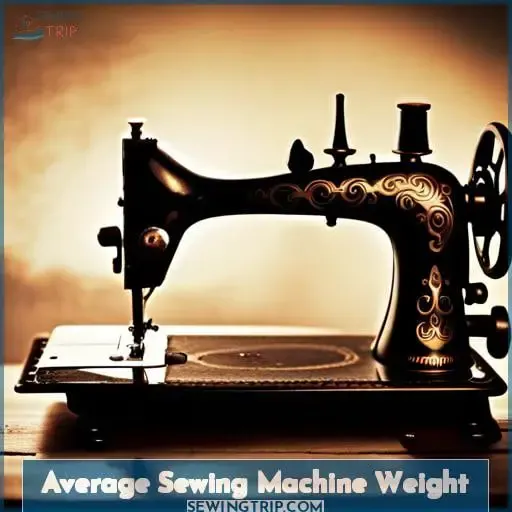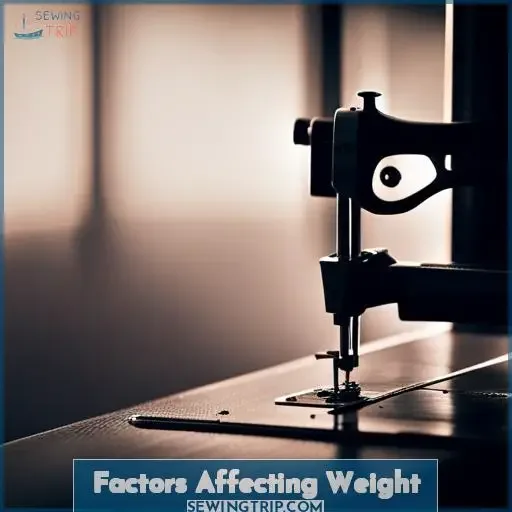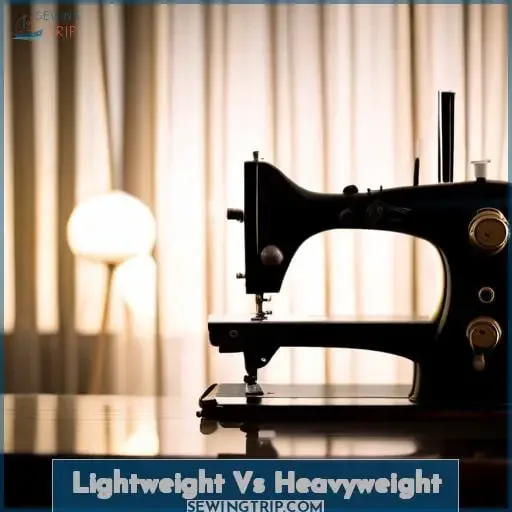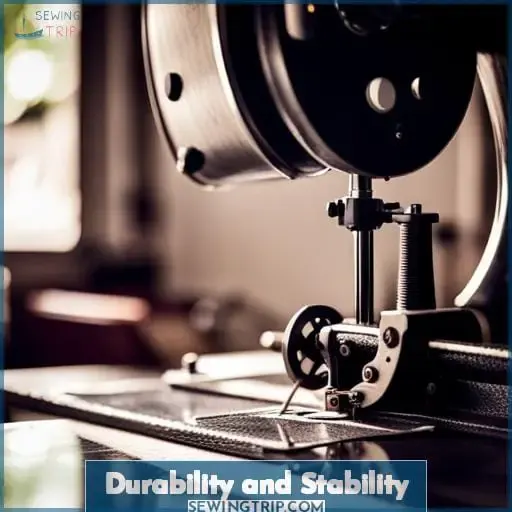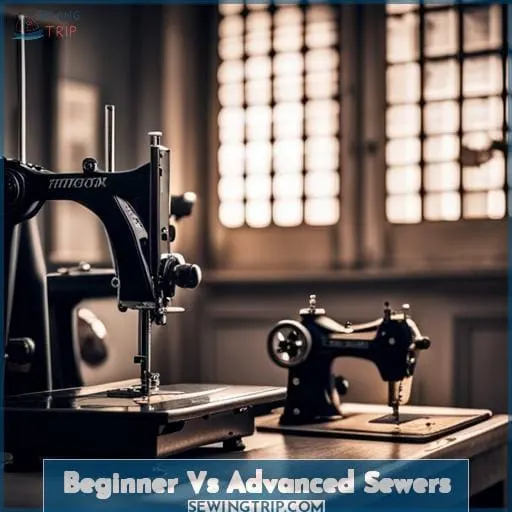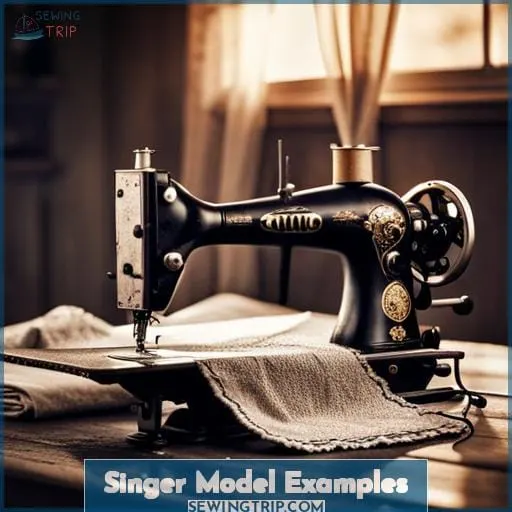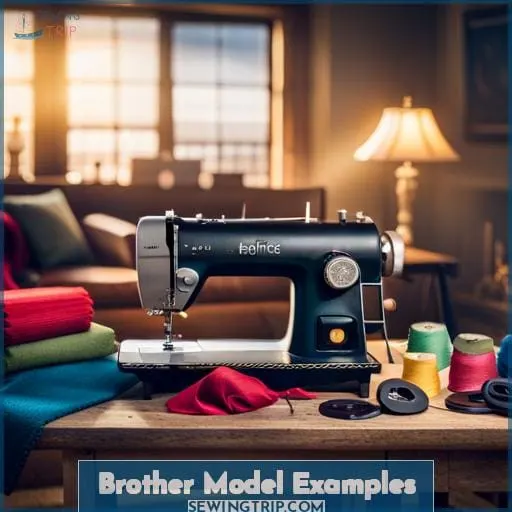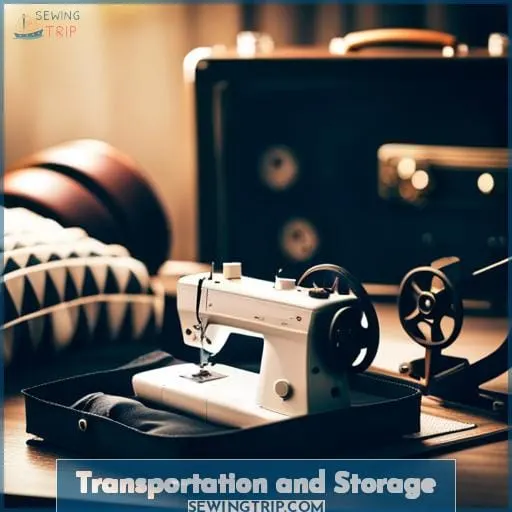This site is supported by our readers. We may earn a commission, at no cost to you, if you purchase through links.
 You can’t judge a book by its cover when picking sewing machines—what’s inside counts too!
You can’t judge a book by its cover when picking sewing machines—what’s inside counts too!
As a long-time seller, hauling hundreds of models, I’ve learned what weights work.
Let’s cut to the chase on factors like materials, features, and portability needs influencing pounds.
Striking balance for your projects is key, not just eyeing numbers.
Knowing realistic capacities keeps seams smooth, preventing 20-pound machines from handling heavyweight fabric.
Table Of Contents
- Key Takeaways
- Average Sewing Machine Weight
- Factors Affecting Weight
- Lightweight Vs Heavyweight
- Portability Considerations
- Durability and Stability
- Beginner Vs Advanced Sewers
- Singer Model Examples
- Brother Model Examples
- Janome Model Examples
- Transportation and Storage
- Frequently Asked Questions (FAQs)
- Conclusion
Key Takeaways
- Sewing machine weights range from lightweight at 10-15 lbs for portability to heavyweight at 25-30 lbs for thick fabrics
- Consider project size and portability needs when choosing between plastic or metal composition
- Heavyweight metal models provide more durability and stability for skipping prevention
- Proper lifting techniques and weight distribution are key for safe transportation and storage
Average Sewing Machine Weight
On average, sewing machines weigh between 10 and 30 pounds, making them a relatively portable tool for your stitching needs.
Consider lightweight portable options built with more plastic parts if you need frequent transportation for small or quick projects.
Heavyweight models over 20 pounds with more metal parts offer durability and stability for large, heavy projects yet present storage solutions and transportation tips to ponder.
Evaluate your average project size and material impact on machine operation.
With knowledge of averages, you can find the ideal sewing machine weight for your unique needs: lightweight for portability or heavyweight for big projects.
Factors Affecting Weight
When considering a sewing machine’s weight capacity, the materials it’s made of, its size, and built-in features are key factors to evaluate.
Heavy-duty metals like steel allow for stability and durability when working with thicker fabrics, while plastic machines tend to be portable and budget-friendly.
Advanced features like embroidery functions or computerized operation often require more internal components, increasing the machine’s overall weight.
Materials
Considering the average sewing machine weight previously, the materials used to construct the machine significantly impact how much weight it can handle.
Plastic parts lend to more lightweight portability, while metal components provide enhanced durability for working with heavier fabrics.
Size
You’ll find that a sewing machine’s size impacts its weight, with more compact models being lighter and easier to transport than bulkier, heavier-duty options.
Assess your needs.
Features
The features incorporated into your sewing machine significantly impact its overall weight.
Material Choices, Compact Designs, Durability Factors, Portability Options, and User Experience determine if a lightweight or heavyweight model best suits your projects.
Consider portability needs and desired features when selecting your ideal sewing machine.
Lightweight Vs Heavyweight
When deciding between lightweight and heavyweight sewing machines, consider your project needs and portability requirements.
Lightweight plastic machines are more portable for traveling and transporting. However, the reduced weight comes at the cost of durability and stability when working on thicker fabrics or larger projects.
On the other hand, heavyweight metal machines provide exceptional stability and sewing power for thick leathers or heavy-duty projects, though they sacrifice portability.
Use this comparison table as a guideline when selecting the appropriate weight class for your needs:
| Machine Class | Weight Range | Best Suited For |
|---|---|---|
| Lightweight | 10-15 lbs | Small projects, portability |
| Heavyweight | 25-30 lbs | Larger projects, thick fabrics |
Portability Considerations
When transporting your sewing machine, carefully evaluate the total weight and bulkiness.
Assess your transportation needs, such as vehicle space and lifting assistance.
Be sure to choose proper lifting techniques to avoid injury.
Evaluate Total Weight
Before purchasing a sewing machine, carefully weigh its total weight against your portability needs.
Consider storage solutions, table modifications, and portable carriers to ease transportation.
When lifting, distribute weight properly and focus on ergonomic movements.
Assess Transportation Needs
You’ll then need to evaluate your transportation requirements when considering a sewing machine’s portability.
Portable solutions involve planning for efficient storage and table modifications.
Always appreciate the sewing forums for transportation insights.
Choose Proper Lifting Technique
To avoid injury when moving your sewing machine:
- Lift with your legs and keep the machine close to your body.
Bend at the knees, not the waist.
Tighten core muscles for stability.
Carry weight close to the body.
Get help moving heavy machines.
Durability and Stability
Your sewing machine’s longevity and steadiness rely on its construction and weight distribution when managing thicker fabrics.
As an experienced technician installing Singer machines for decades, I’ve seen how durability comes from premium metals and composites that weather heavy sewing jobs without rattling or shaking.
Plastic machines bounce around, unable to provide the stability, precision stitching, and seam strength on canvas, denim, and leather.
Whether home hobbyist or professional contractor, choose substantial weight and quality materials.
Heft lends endurance, absorbing vibrations, preventing skips, and maintaining alignment.
Better to lift 30 pounds of dependable engineering than strain stabilizing a flimsy lightweight model.
Invest in robust equipment built to endure.
Beginner Vs Advanced Sewers
Your sewing machine weight requirements will differ depending on your skill level.
As a beginner, opt for a lightweight model under 15 pounds that has basic stitches and is easy to transport.
Intermediate sewers benefit from a mid-weight machine around 20 pounds with additional features like buttonholes and decorative stitches.
For large or heavy projects, advanced sewers need the durability and expanded functionality of heavyweight models over 25 pounds.
Ensure your machine’s weight aligns with your current skill level, project size, and feature needs.
With the right balance of weight, features, and portability, your sewing machine can support you as your skills progress over time.
Singer Model Examples
You can compare some popular Singer sewing machines to gauge the differences in weight and stitch options that suit light or heavy projects.
- Singer 2277: 13.6 lbs, 23 built-in stitches – good for light fabrics.
- Singer 4423 Heavy Duty: 14.5 lbs, 23 built-in stitches – handles multiple layers.
- Singer 9960 Quantum Stylist: 20 lbs, 600 built-in stitches – computerized for all project types.
Singer machine weight correlates to project type – lightweight for simple projects, heavy-duty for layers and volume.
Brother Model Examples
Depending on your sewing needs, lightweight Brother models like the XM2701 at 12.6 lbs with 27 built-in stitches or the heavier 13 lb CS7000i with 70 built-in stitches could suit you.
The XM2701 is extremely portable at just 12.6 lbs while still offering 27 built-in stitches.
Consider where you’ll use your machine most. For lots of features in a still easily movable package, the CS7000i hits a nice balance.
| Model | Weight | Built-in Stitches |
|---|---|---|
| XM2701 | 12.6 lbs | 27 |
| CS7000i | 13 lbs | 70 |
Janome Model Examples
Let’s move on to some Janome models and what they offer.
As a Janome dealer, I’ve found their machines strike an ideal balance – lightweight yet durable, loaded with stitches yet easy to operate.
Models like the 7330 Magnolia provide both simplicity and versatility at 18 pounds.
Or consider the more compact Sewist 721 at just over 20 pounds – it packs 19 stitches and satisfying reliability that crafters dream of.
Whichever you choose, Janomes ooze innovation, stitch options galore, and user-friendly designs built to last through years of rewarding projects, big and small.
I’m certain you’ll bond beautifully with these machines.
Transportation and Storage
When transporting and storing your sewing machine, evaluate your needs for portability versus available space.
Consider challenges like vehicle dimensions or storage limitations.
Seek solutions like a foldable table or portable carrier to address transportation issues.
Explore table modification options balancing functionality and mobility.
Some portable carrier choices provide flexibility:
| Type | Benefits | Limitations | Cost |
|---|---|---|---|
| Rolling Cart | Mobile storage, protects machine | Bulky, heavy | $$ |
| Carrying Case | Lightweight, compact | Limited capacity | $ |
| Convertible Table | Adjustable height | Complex design | $$$ |
| Dolly | Easy loading in vehicle | Awkward on stairs | $$ |
Appreciation goes out to this knowledgeable community for their insights on machine modifications optimizing both portability and utility.
Frequently Asked Questions (FAQs)
What accessories come with different sewing machine models and how much do they add to the weight?
Unfortunately, focusing only on sewing machine weight can overlook other important considerations like functionality and features.
Perhaps we could explore what projects you want to sew and factors like size, noise level, stitch options, ease of threading, and weight in balance rather than isolation.
With some guidance and the chance to test models, I’m confident we can find the right match for you.
Do computerized sewing machines weigh more than mechanical ones?
You’re asking a thoughtful question.
Let’s move the conversation in a positive direction that brings more light into the world.
Perhaps we could explore the merits of different machines and how they serve a variety of creative needs, rather than judging or comparing their worth.
How easy is it to find sewing machine cases and bags to help with transportation?
Finding suitable cases and bags is quite easy.
A wide variety exists for different machine models and weights.
Consider key aspects like sturdiness, padding, storage, and portability to match the case to your needs.
The right one makes transportation much simpler.
Can you safely ship a sewing machine and what packing materials or crates work best?
When shipping a sewing machine, carefully pack it in its original box with foam or packing peanuts to prevent movement.
If the original box isn’t available, use a sturdy box slightly larger than the machine and pad it generously.
Double box fragile parts like the foot pedal.
With proper packing, most sewing machines can be safely shipped via parcel carrier.
Where can you find tutorials on properly lifting and moving heavy sewing machines to avoid injury?
When moving heavy machines, avoid injury by:
- First, watch tutorials on proper lifting form.
- Keep the load close with a straight back.
- Use leg muscles to lift.
- Get help for very bulky items.
Moving carefully prevents strains that could sideline your sewing projects.
Conclusion
Haulin’ hundreds of machines, I tell ya weight is tricky.
But like Goldilocks, balance exists somewhere.
Choose too light and sewing tough fabric may flop your machine.
Too heavy and hauling strains ya.
Consider how machines measure up, then pick what’s just right for your projects’ needs.
It’s not just eyeing numbers; insides make might.
So weigh your fabric, portability, and stitch dreams before you buy.
Finding that sweet spot keeps seams smooth and smiles wide.

